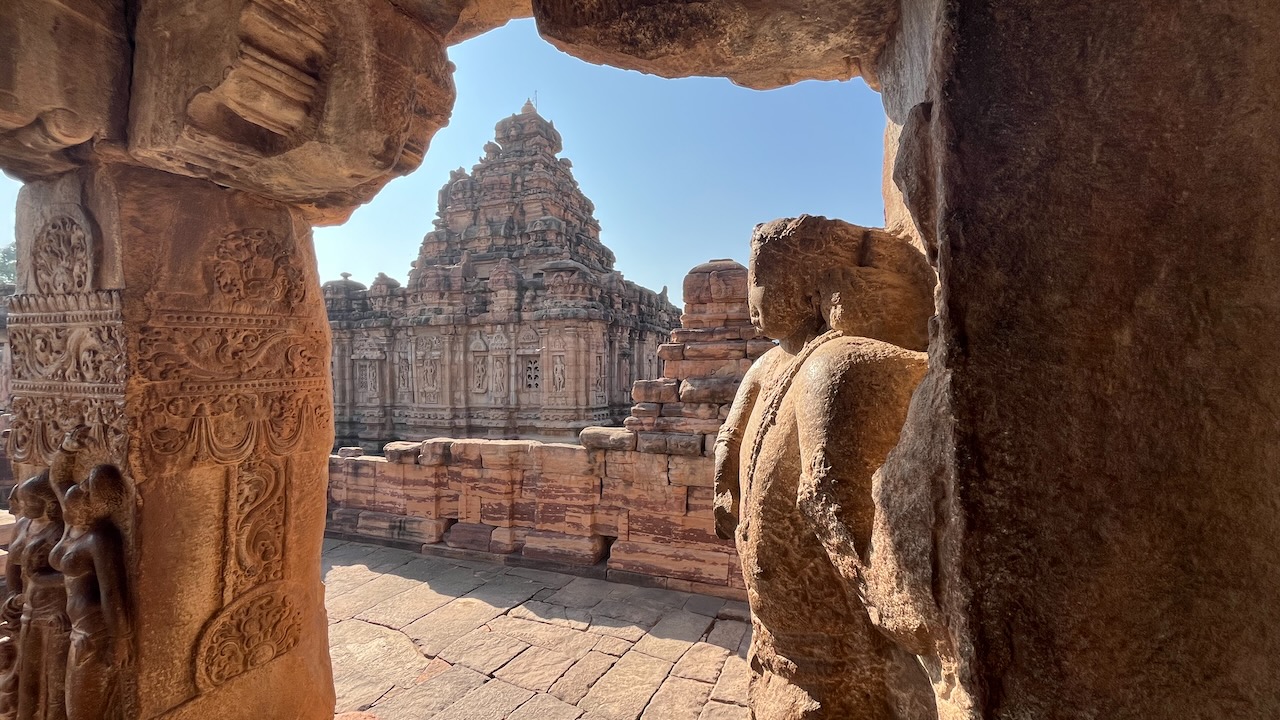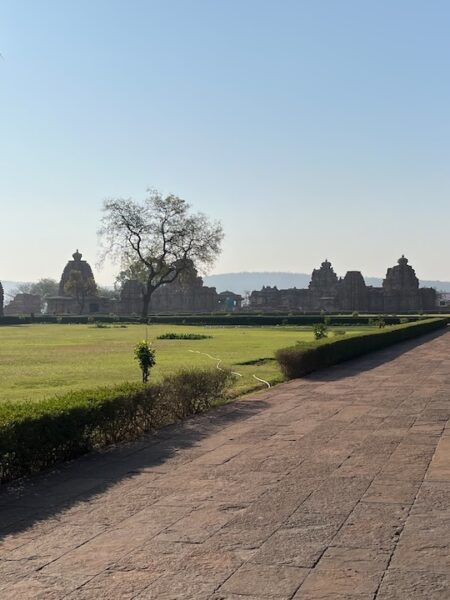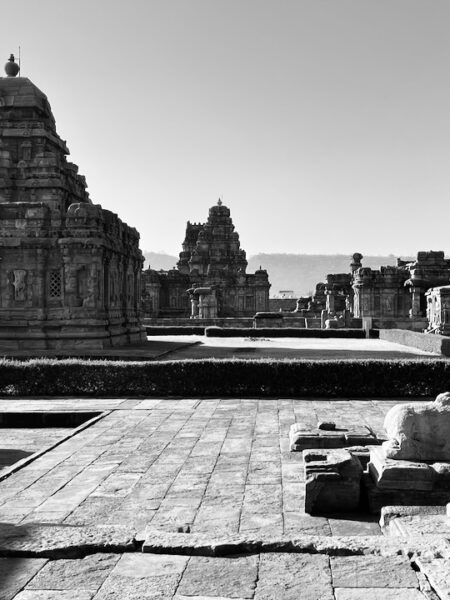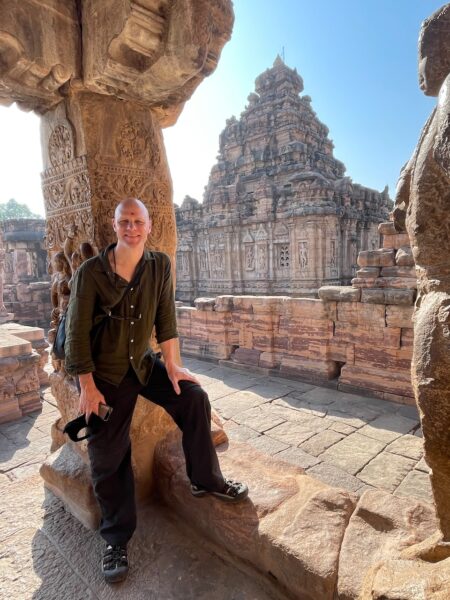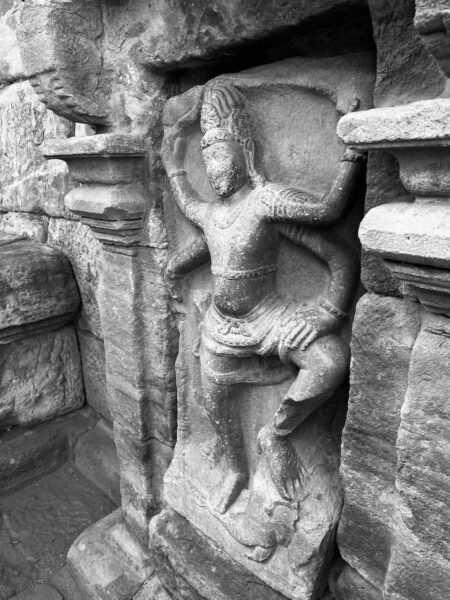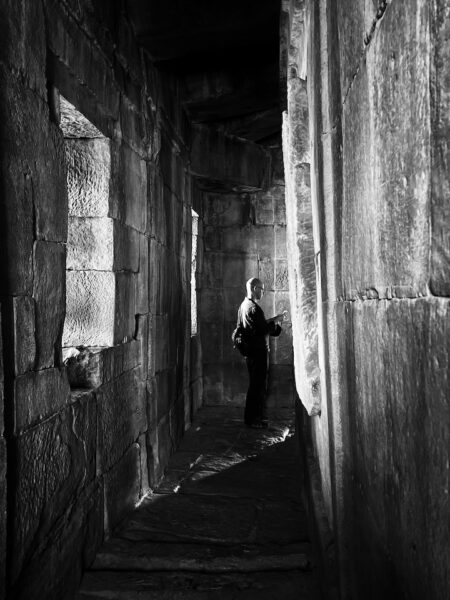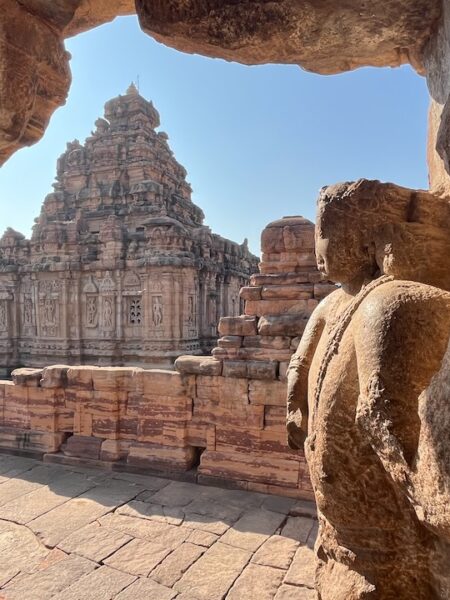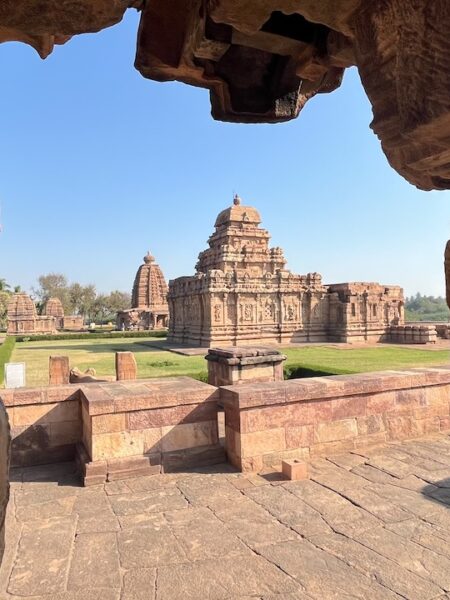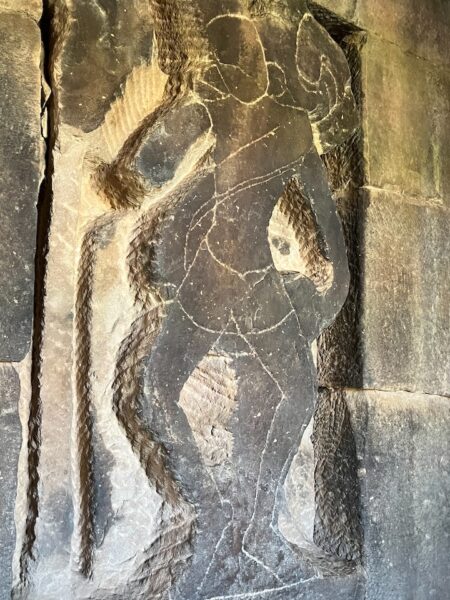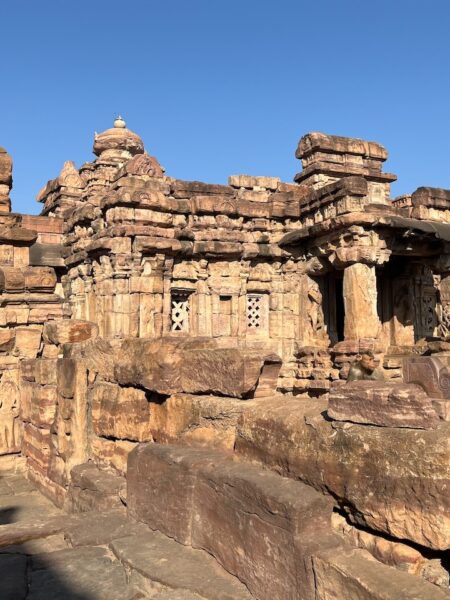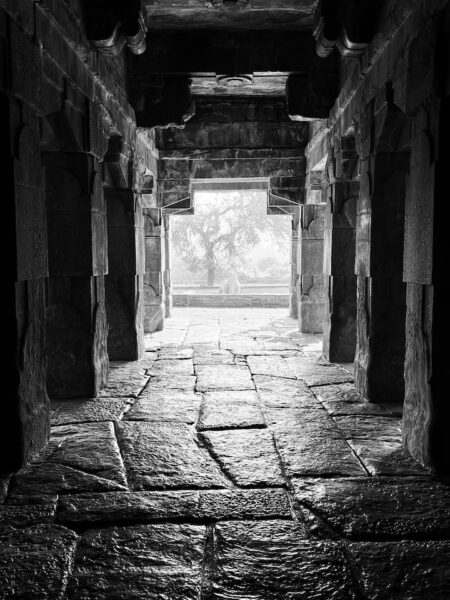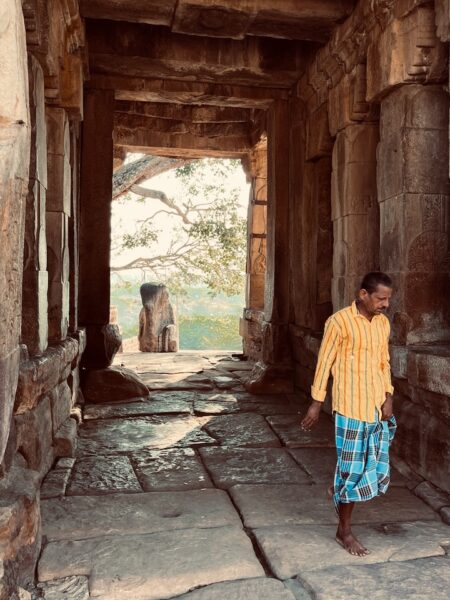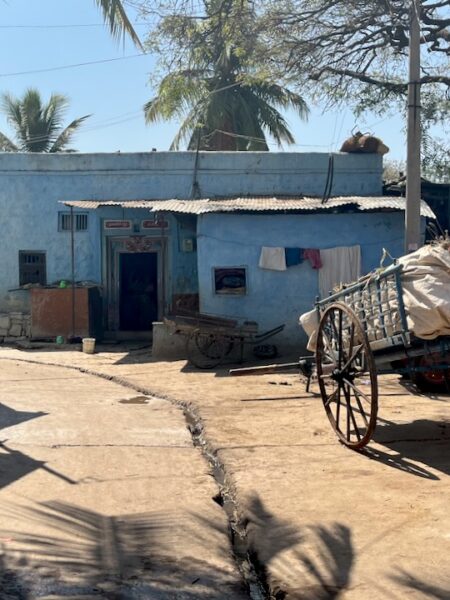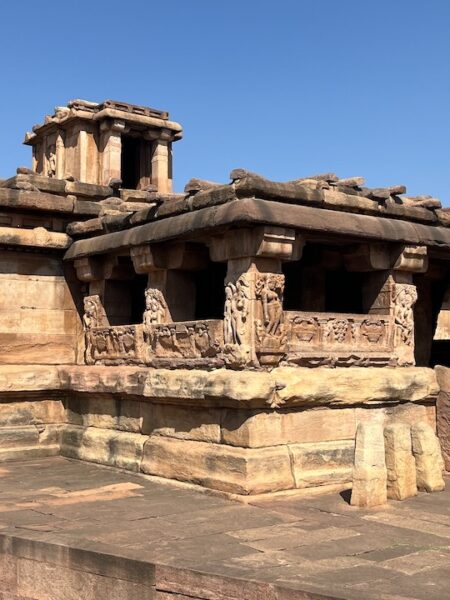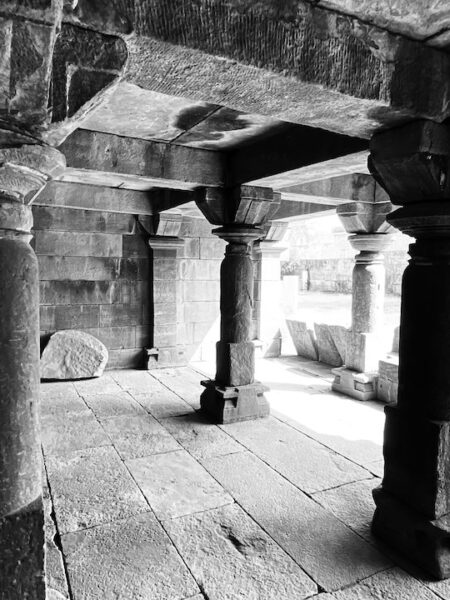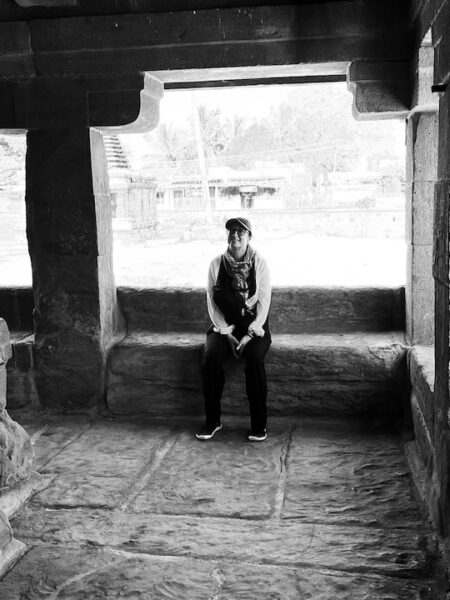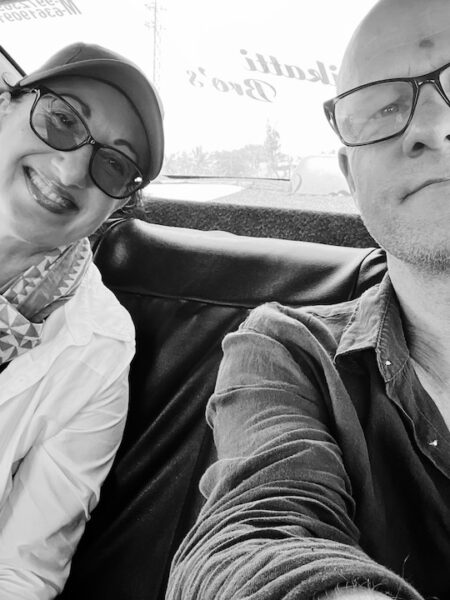Another very uncomfortable, fitful sleep due to the noise from the main room and the lights shining into our room through the upper windows. And yet the caretaker probably thought we were his most satisfied customers ever as I gave him a tip, Carol praised his basic food, and he took a selfie with us when we left!
Our driver had transformed from the younger, less confident guy I met last night into an older guy called Mahmoud who turned out to be great – efficiently driving us from Badami to Pattadakal to Aihole and finally to our hotel in Kamalapur, south of Hampi. In the middle of a sleepless night Carol had brilliantly managed to change our accommodation to somewhere much better, now that she understands better the reality (or should I say unreality) of local Indian accommodation reviews on Trip Advisor.
Pattadakal is just 20km from Badami, so we were there nice and early before 8am. The Chalukya temples from the 7th and 8th centuries are in an attractive compound with green lawns and swept pavements, and face a river to the east. As with all of these sites, you pay your fee, which is usually 10 times more than it is for Indians, to someone behind a ticket counter who prints out your tickets, then photographs them with a smart phone; then you walk a few steps over to a gate where a guard solemnly examines the tickets before tearing the top of them, handing them back to you and waving you in. Everyone needs a job I guess.
Almost immediately a young couple asked us for selfies (by the end of the day we were starting to politely refuse these requests, there were so many). The temples are all dedicated to Shiva, and in general follow the usual plan of main chamber with an interior sanctuary usually featuring a linga (the abstract representation of Shiva), and sometimes a passageway around the main chamber.
In the main Virupaksha temple, the linga was decorated, and a priest went through the quick puja blessing with me, daubing a tilak mark on my forehead with red powder and directing me to wave my hand over a tea light on a tray, then wave over my head. Then he pointed to the 200 R note on the tray – but seemed satisified with the 10 R note I gave him. Carol didn’t come inside as she’d forgotten her scarf; not that it’s a requirement for women to cover their head in Hindu temples.
Outside this temple was a pavilion housing a beautiful big Nandi bull statue (the mount of Shiva) with a chanting monk sitting next to it.
The site was a gorgeous selection of sandstone temples – though, being sandstone, very worn and melted-looking – and a perfect setting in which to quietly wander in and around them.
Back at the car and a short drive to Aihole (stop sniggering at the back – it’s pronounced ay-ho-leh). Here the very small village seemed permeated by scattered ruins, though one main area was fenced off. A 7th century Durga temple was the most impressive building, though I particularly liked a large stepped tank with green water at the bottom (a fish flopped, so there was life in it). There was a small museum that repeated the information panels from the one at Badami, but housed some nice sculptures much worn by the elements.
Afterwards we wandered a bit through the village and found other isolated groupings of ruined temples, but their poor condition and the roving packs of small boys asking repeatedly for pens – and in one case, chocolate – meant diminishing returns, so we went back to the car. It was early afternoon by this time and the sun was starting to beat down.
It was an easy two and a half hour drive to where we’re staying now, the Mango Tree Homestay, which is ten times better than the Badami place; clean and spacious and –surely this is no coincidence – run by a non-nonsense businesswoman. She also owns and runs a restaurant of the same name 20 minutes walk away which is apparently the best in the area, so I’m looking forward to some good food.
After relaxing in our room for a while and studying up on the huge number of monuments in the wider area (something like 3700 of them!), we walked to the aforementioned restaurant through the town, looked at by lots of locals and greeted with ‘HI!’ by innumerable children. This is one of my favourite things to do while travelling, just walking through a village seeing all the people, how they live, and all the stuff they’re up to. Walking in India like this is a full-on sensory experience!
The restaurant is a big, open-sided barn-like building, very efficient and clean, with friendly staff, and seating divided into a normal seating area and an area of floor-level padded benches around low tables. We were directed to the former. Carol had paneer masala and I had Khaju masala, a delicious creamy curry with cashew nuts; and flat naan bread and a huge bowl of tasty raita (minty yogurt sauce). We both had two very refreshing ginger and lemon drinks each (no alcohol was available). Then, for desert, I had a slice of banoffee pie, a British desert of toffee, banana and biscuit crust very popular in India. We were laughing about an online article saying it ‘opened up new worlds’ to the writer when they first tried it – and then I tried it and it was amazing – thick, rich, chewy, and delicious!
The entire meal cost about NZD$26. How incredibly satisfying it is to have a good, fresh, well-cooked meal for a cheap price (an experience sadly no longer possible in New Zealand). I’m very relieved this place is so good, because we’ll be eating here a lot over the next few days!
The manager called us a tuk-tuk and we were back in our comfortable room about 8.15pm and very much ready to crash after the long day.

